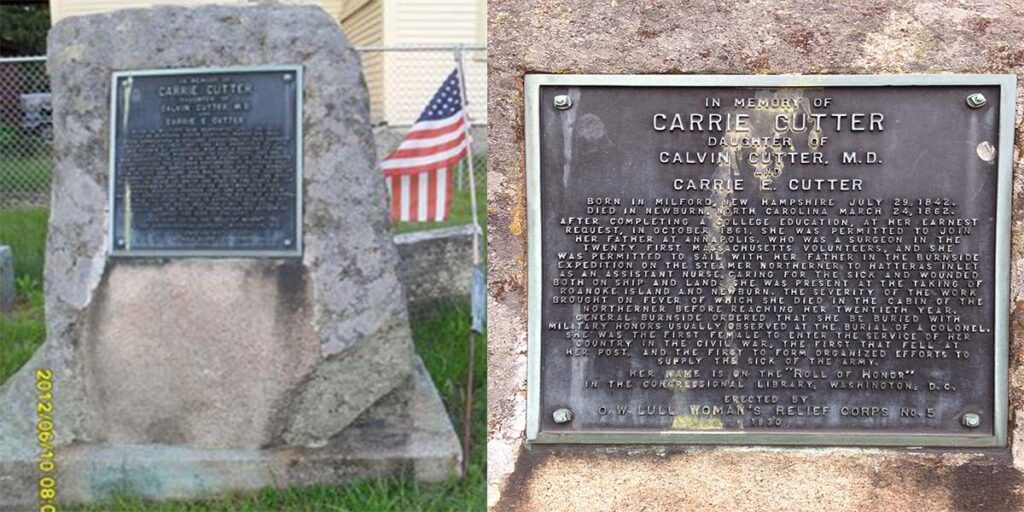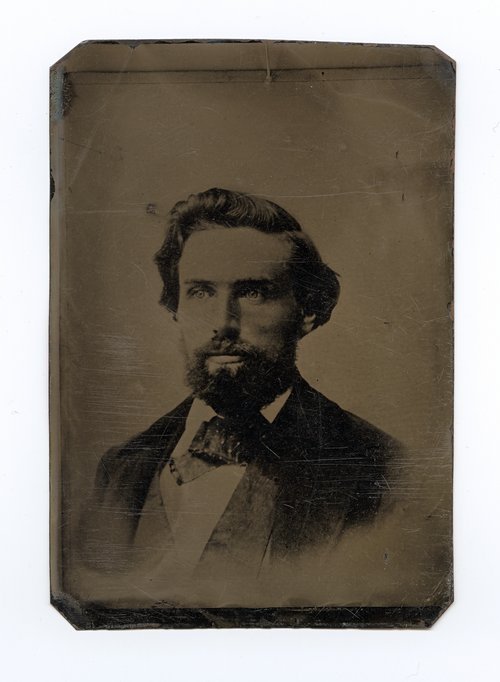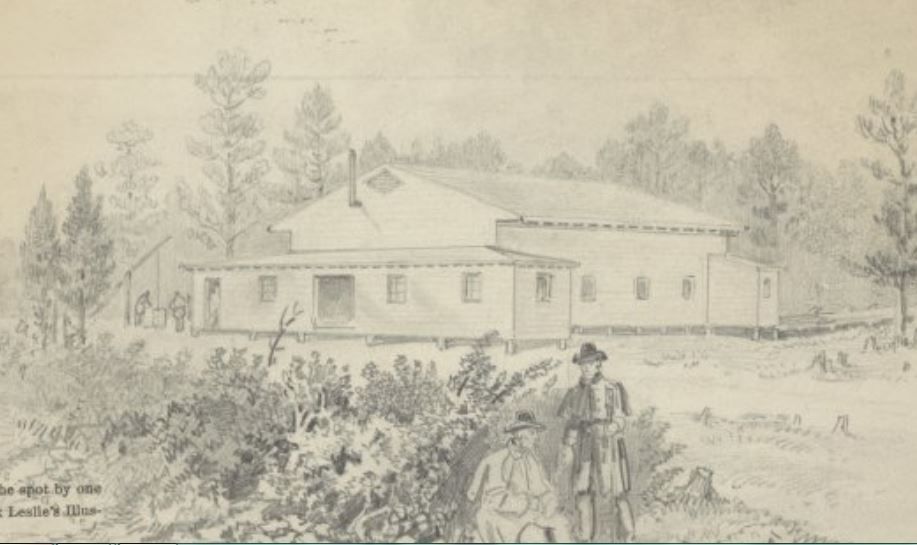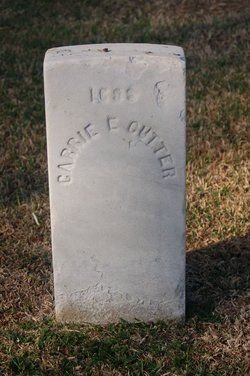Table of Contents
If you go to Elm Street Cemetery in Milford, New Hampshire, and look in the first row of graves, you will see a large memorial boulder with a plaque dedicated to the memory of Carrie Cutter. The inscription states in part that Cutter was the “first female to enter the service of her country in the Civil War, the first that fell at her post, and the first to form organized efforts to supply the sick of the army.” So, who was Carrie Cutter and what is her story?

Carrie E. Cutter was born in Milford, NH on July 29, 1842. Her parents were Dr. Calvin Cutter and his wife, also called Carrie. Her mother died only a month after giving birth to her. Dr. Cutter eventually remarried, and at the time of the Civil War, the family had moved to Warren, Massachusetts. Described as a “beautiful and accomplished daughter, lithe, well formed, fine featured, with gray eyes and light brown hair,” [1]Cutter began her education at a private seminary in Lancaster, MA, and then at Mount Holyoke Female Seminary (now Mount Holyoke College). She then attended a private German school in Pennsylvania, and by April 1861, she was ready to depart on a three-year tour and study in Europe. However, the start of the Civil War ended her plans.

Dr. Cutter, who was a staunch abolitionist and had been active in Kansas prior to the Civil War, immediately signed on as a surgeon in the 21st Massachusetts Volunteer Infantry, going into camp in July 1861. His daughter had often assisted her father when he visited patients, and she too wanted to do her part in the war. Her brother, John, a doctor in his own right, remembered seeing his sister “distribut[ing] New Testaments to the volunteers drawn up on the railway platform . . . on the morning of their departure for camp.”[2] Cutter also organized ladies’ aid societies to roll bandages and send medical supplies to the newly established army hospitals.
In October 1861, after repeated requests, Cutter was allowed to join her father in camp at the Naval Academy in Annapolis, Maryland, serving as his secretary and nurse. When General Ambrose Burnside launched his expedition to North Carolina in February 1862, Cutter was allowed to accompany her father and the other officers of the 21st Massachusetts on the steamship Northerner. After a perilous journey through a winter gale off Cape Hatteras, Cutter and her father arrived in time to witness the Battle of Roanoke Island, on February 8th.

During the battle, Cutter found herself caring for a young man that she knew from home—he had actually lived with her father’s family since 1860. Charles Plummer Tidd had accompanied Dr. Cutter to Kansas prior to the war, and there he had joined John Brown’s army of abolitionists. After Brown’s unsuccessful raid on Harpers Ferry in 1859, Tidd had escaped capture and changed his name. The Cutter family provided a refuge for him in Massachusetts. When the Civil War began, he enlisted along with Dr. Cutter in the 21st Massachusetts. Tidd never saw action in battle, as he contracted typhoid fever while onboard the ship Northerner. Cutter nursed him but he died on February 8th as the battle raged onshore.

After the battle, Cutter went ashore to assist in the care of the sick and wounded. Because of her former schooling in German, she was asked to care for three soldiers who were ill with typhoid fever and could not speak English. It was probably during this time that she contracted the disease herself. When the Northerner set sail at the beginning of March to follow the army to New Bern, NC, Cutter was suffering from fever and exhaustion. Her father was unable to be with her until March 19th. According to a manuscript at the Library of Congress containing biographical notes about Cutter, her father asked her several times that should she not recover, would she regret coming out on the expedition. Cutter supposedly replied, “Most surely not.”
As her condition worsened, Cutter requested that she be buried next to Tidd on Roanoke Island. She died in her cabin on the morning of March 24, 1862, at the age of 18.
Her comrades in the regiment were devastated—calling her “the Florence Nightingale of the 21st.” When General Burnside learned of her death, he arranged for a special steamer to bring her remains to Roanoke Island, where she was buried beside Tidd with full military honors. When the National Cemetery was established in New Bern, the Secretary of War directed that she be interred there. She was one of the first women to give her life in the Civil War and one of the first to be buried in a National Cemetery.

Cutter’s name can be also found on the Roll of Honor in the Library of Congress in Washington, DC and on a monument to her in Warren, MA. Most fittingly, she was also honored by one of her peers, and perhaps the most famous woman nurse in the Civil War, Clara Barton. In 1892, Barton wrote a poem in honor of all the women who served in the war. Entitled The Women Who Went to the Field, part of the last stanza reads:
A few names where writ, and by chance live to-day;
But’s a perishing record fast fading away.
Of those we recall, there are scarcely a score,
Dix, Dame, Bickerdyke, Edson, Harvey, and Moore.
Fales, Wittenmeyer, Gilson, Safford, and Lee,
And poor Cutter dead in the sands of the sea.
Endnotes
[1] Biography from Historical Society of Cheshire County
[2] Cutter, John C., letter to New Berne Daily Journal, March 1895
About the Author
Tracey McIntire earned her BA in English at Rivier College in Nashua, NH. She is Director of Communications at the National Museum of Civil War Medicine, an interpretive volunteer at Antietam National Battlefield, a Historical Interpreter at South Mountain State Battlefield, and an active Civil War living historian, where she portrays a woman soldier in various guises. She graduated from high school in Milford, NH, where she first learned about Carrie Cutter.
Sources
Barton, Clara; “The Women Who Went to the Field,” poem, November 1892
Boston Traveler, April 20, 1869
Cleveland Leader, April 19, 1862
Cutter, John C., letter to New Berne Daily Journal, March 1895
Dargie, Paul; Milford NH Blog
Higginbotham, Susan; A Memorial Day Tribute to Charles P. Tidd and Carrie Cutter, blog post
Ladenbush, Alexis, biography of Carrie Cutter for Historical Society of Cheshire County
Ramsdell’s 1901 History of Milford N.H.
Salisbury, Jessie; “Granite State Mystery: Curious Case of Milford’s Carrie Cutter,” Nashua Telegraph, December 22, 2016
Wright, Winifred A., The Granite Town: Milford, New Hampshire, 1901-1978


